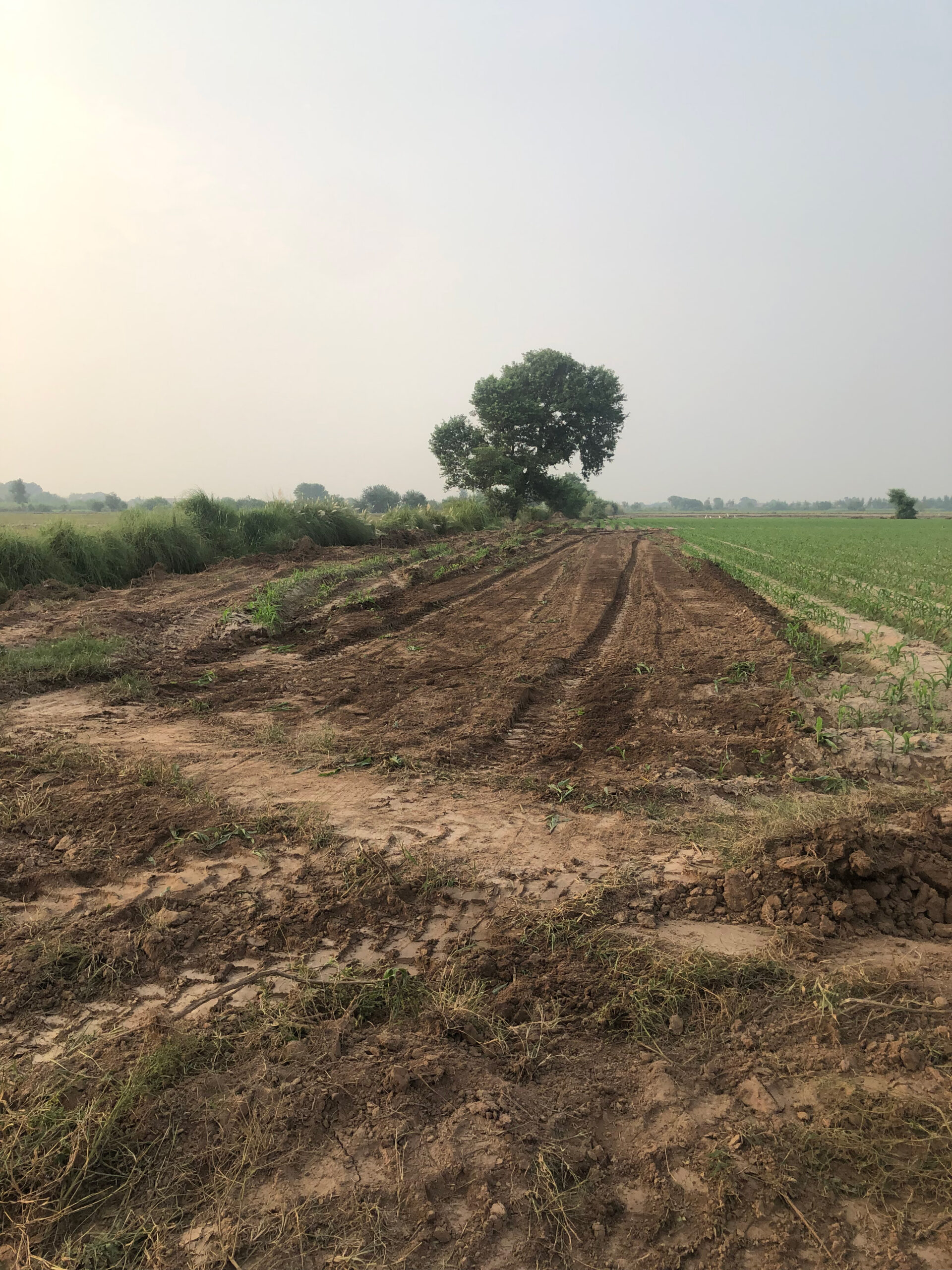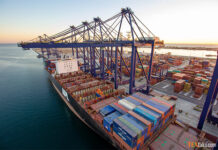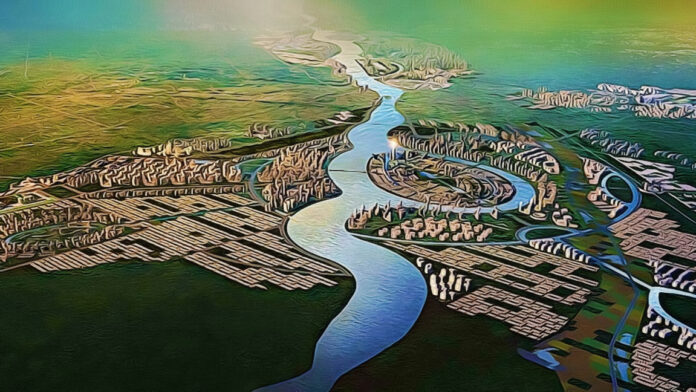The bulldozers came at the crack of dawn, and they came with no warning. As they rumbled through farmland with the watery September sun at their backs, they were accompanied by a small army of private guards and officials from the Ravi Urban Development Authority (RUDA). Tenants and landowners that farm the land watched on with resignation while their crops were destroyed and waterways blocked.
For the past two years, what was a quaint chunk of farmland away from the humdrum of Lahore has been the site of a cold war between the state and an agrarian community that has existed for generations along the banks of the Ravi. The moment those bulldozers arrived on the horizon, however, the cold war was over. This was an invasion. Since then, the bulldozers and guards have reappeared almost everyday to level crops and stop anyone from harvesting.
Under dispute are roughly 4,000 acres. For the farmers who live here this area is Ferozewala, a rich swathe of agricultural land directly fed by the Ravi and lush with guava orchards and seasonal plantations of maize, wheat, pumpkins, and other cash crops popular in farmlands close to the edges of Lahore’s peri-urban sprawl. For the officials of RUDA, it is Sapphire Bay — the location for phase one of the Ravi Riverfront Urban Development Project. And since they claim that the land is theirs, legally acquired and possessed, they are now within their complete rights to bulldoze and bully as they please.
The Ravi Riverfront Project is many things. At its best, it is a vain, bloated, misguided attempt that many environmentalists and hydrological experts have called an impending ecological and social disaster. At its worst, it is an uncaring attempt to turn the Ravi and its embankments into a playground for real estate developers that intend to treat it as a cash-cow for at least the next two decades.
For better or worse, it has become a bone of contention with political undertones. A pet project of former prime minister Imran Khan, it was declared illegal and unconstitutional by the Lahore High Court last year and has recently been given reprieve by the Supreme Court. That verdict in addition to the PTI back in charge in Punjab may be what is behind the latest attempt by RUDA to seize lands that they claim they have legally acquired and which the owners of these lands say have not been.

Largely forgotten in the midst of this tussle is the Ravi itself. After all, the project will have an impact on the fate of the river, and along with it all of the people who draw their livelihoods, homes, and identities from the river. Profit met with farmers, landowners, hydrologists, engineers, lawyers, and activists as well as RUDA chairman Imran Amin to understand what is going on in Ferozewala right now and what will become of the project. To understand it entirely, we go back to the very beginning.
Origins
The idea for a riverfront project on the banks of the Ravi is not a new one. In fact, it was first proposed as far back as 2006, and underwent a feasibility study in 2013 under the PML-N government. The idea has long been a lucrative if elusive pipe-dream. Lahore, as many are aware, has swelled up and its urban sprawl has seen it become one of the most polluted cities in the world which regularly tops the global rankings for the worst air quality.
Decades of unbridled real estate development, unsustainable horizontal growth, and massive coal power plant projects in adjoining cities have left the ancient Mughal capital on the path to being unlivable. There is much that could be done to solve Lahore’s problems. For starters, a viable network of public transport could reduce the city’s growing traffic congestion and restrictions on real estate development and the encouragement of vertical growth could help contain the sprawl. Investments could be made for forestation and an overall plan to make the city more high-density, more walkable, and most importantly more liveable.
Ideas like the Ravi Riverfront Urban Development Project are the sort of sweeping solutions that populists like to extoll. Essentially, the Ravi riverfront is the plan to make a new city from scratch. The project would be Pakistan’s second-largest planned city after Islamabad, covering an area of 102,074 acres, catering to a population of up to 15 million people. It is an ambitious undertaking — one that is born as much out of a sense of frustration with the state of our urban centres as it is out of necessity. In fact, in a comprehensive and eye-opening article published in Dawn back in June 2021, it was pointed out that the development of new cities and riverfront projects is not unique to Pakistan, and that such projects and several new cities have been planned across Asia and Africa in recent years.
It is essentially a desire to start from scratch. To plan and control and build a city with the benefit of hindsight. The foundation rock for the utopian riverfront project was first laid in 2019 with the passage of the special legislation that established RUDA. The authority would not work under any other body in or related to Lahore, and would have complete control over the project. In fact, the Lahore Development Authority (LDA) and similar bodies in Gujranwala and Sialkot would be subservient to RUDA. So complete were the powers given to RUDA that not only was the authority entrusted with the entire responsibility for the project from planning, to acquisition, to development that the legislation which created RUDA granted the authority and its employees immunity from all legal proceedings, and “no court or other authority” can “question the legality of anything done or any action taken in good faith under this Act, by or at the instance of the Authority.”
The court cases
From the get-go, the warning signs were present. The law that had created and empowered RUDA seemed to go beyond reasonable limits because of the lack of accountability that the authority had to office. By early 2021, when the project was in its early stages of acquiring land, troubles began to rise when local communities resisted selling their lands to the state after which RUDA announced that it would feel free to acquire the lands by force — something that article 4 of the special legislation that RUDA created allowed. The matter went to court. In January 2022, Justice Shahid Karim of the Lahore High Court (LHC) in a 298-page long judgement declared that the scheme was “unconstitutional” on the grounds that it lacked a master plan.
Justice Karim said that the RUDA failed in preparing a master plan in accordance with the law as “all schemes are under a master plan”. The court noted that proper procedure was not adopted in purchasing agricultural land for the Ravi Urban Development project in Lahore and Sheikhupura, therefore, it declared the practice of acquiring the land through amendment in Section 4 of the RUDA Ordinance “unconstitutional”. RUDA was barred from acquiring land for the project.
The then prime minister Imran Khan immediately visited the project site and announced that his government in Punjab would challenge the verdict in the Supreme Court. Less than a month later in February, the Supreme Court threw out the LHC’s detailed verdict after less than 10 days of hearing and deliberating on the matter. The two-judge Supreme Court consisting of Justice Ijaz-ul-Ahsan and Justice Mazahar Ali Akbar Naqvi held that RUDA could continue working on lands it had already acquired, but barred it from undertaking any work on the ground beyond the lands that had already been acquired, possession taken and compensation paid.
“It is brazen land grabbing”
“In December 2021, the Lahore High Court passed a judgement that declared the RUDA law illegal and unconstitutional. In January 2022, within 10 minutes, the Supreme Court put a stay on the very well reasoned and detailed judgement passed by the LHC. Even then the SC held that RUDA could only operate on the land that it had already acquired, paid for, and possessed,” explains Ahmad Raffay Alam, a lawyer and activist that has been working on the ground with those affected by the project. “This is nothing short of a brazen land grab. This is complete horseshit. And you can quote me on that.”
The words are harsh but they may ring true. To hear Alam speak, the project does not have anything to do with containing Lahore’s urban sprawl or for that matter with once again making the Ravi a bastion of life. “It is a very simple ploy,” explains Alam. “By forming RUDA they have a body on their hands that is empowered and can under article 4 acquire land by force. When land acquisitions happen, the government is only really obliged to acquire this land at a DC rate. This rate is significantly lower than the market value of the land. These developers will buy the land cheap at the DC rate, develop it, sell files, and make huge profits off this unconstitutional lie.”

It is worth wondering a little what this means, because as we will see further ahead DC rates, market rates, and everything in between are a major talking point for the stakeholders in this entire situation. Pakistan currently has at least three different ways to evaluate real estate prices. There is the DC rate, which is usually almost 10 times lower than the actual market rate, and then there was the FBR valuation rate which was around three to four times less than the actual market rate. The DC rate is the official price that is quoted on transfer documents and the likes. Since the government charges taxes on the sale and purchase of property as a percentage, it is in the interest of both buyers and sellers to quote a smaller price in the documents and exchange whatever the real value was determined off the books.
This means that whenever the state requires land and undertakes acquisition efforts, they compensate people through the DC rate which means they end up getting shortchanged. RUDA claims that they have figured out a mechanism to solve this problem. “The board of revenue is responsible for the acquisition payments and they pay in accordance with the DC rate. In this area, the rate of land was Rs200,000 per acre for lands that are right on the bank of the river and prone to becoming a part of its course, and Rs 400,000 per acre for the land a little further out,” says Imran Amin, chairman of RUDA.
However, since RUDA is an empowered organisation, Amin claims that they came up with a system whereby landowners that felt they were not compensated enough would be given developed files for plots in the riverfront project. “We have announced the file price of the plot at Rs500,000 per marla and for this we have also taken a commitment from these people that if their plot file is not sold in the market for one year, then the authority will buy it itself. This means we are buying land worth Rs800,000 per acre for as high as Rs3.7 million per acre,” says Amin.
There is however an issue with this logic. For starters, all of the land values being determined here are being done by RUDA themselves. To hear the landowners speak of it, they first underestimate the price of the agricultural land and then overshoot estimates of what their files will be worth in a year — not to mention there is no knowing whether the project will be successful or received well within the market.
It must be said that this is deeply ironic. As has been mentioned earlier and pointed out on other occasions ad nauseum, one of the biggest reasons for Lahore’s urban sprawl is the impunity with which the real estate industry develops unnecessarily and ties up capital and useless plots and plazas. The same real estate craze that has led Lahore to these unfortunate circumstances is what is currently driving the Ravi Riverfront project. The same real estate tactics that can be found in Lahore can now be found at the edge of the Ravi.
“Everything RUDA has ever said is a lie,” says Alam. “I am saying this openly: they are thieves that are exploiting people. There is nothing about controlling urban sprawl; this is simply minting real estate money. The Ravi Riverfront Urban Development Project is nothing more than a yateem khana that houses retired brigadiers and others of the same ilk”
In all fairness, Amin claims that the farmers protesting RUDA’s movements are landowners unhappy with their compensation trying to drive up the price. When asked about the direct complaints of some of the affectees, he refuses to comment. What he does say, however, is that RUDA has been good to these farmers and they are now trying to blackmail them.
“The perception of bulldozers running on agricultural land is being misconstrued and attempts are being made to politicise it. This land belongs to us. Farming on it is illegal. Last year, since the case was pending in the court, we allowed people to grow crops and this permission was given by the authority, but the BOR said that we have made payment for this land and after that we have to take possession of it in the form of Clear-land.”
There is an issue here again. For starters, RUDA could not have ‘allowed’ anything after the LHC’s verdict since its own existence had been called into question by the ruling and it had been told to cease and desist. On top of that, the farmers in this area claim that payments have not been made to them — which would make it in violation of the recent stay given by the Supreme Court which restricts RUDA to work only on lands that they have already acquired, paid for, and possessed. And that is where the current resistance is being put up.
The state of Sapphire Bay
We started with the bulldozers, and now we come back to the people standing in front of those very machines. Large, talkative, and shrewd Sajjad Warraich would like to cut the image of the rural rebel. He is one of the largest landowners in the area that RUDA claims is earmarked for phase one of their riverfront project called Sapphire Bay. He has also been one of the most vocal. Sitting on plastic lawn furniture on the veranda of a white washed dera, he meanders in great detail. There is nothing quite as appetising for an old man with stories to tell than a captive audience.
But in the midst of languid extolations on the Russia-Ukraine war and anecdotes from his youth he holds one staunch claim — that his land is being illegally occupied by RUDA. Warraich claims that RUDA is acquiring more farmlands forcibly and in violation of a recent order of the Supreme Court instructing them to only continue development on land they have already acquired and paid for.
“This land that you see here is what feeds all of Lahore. Fresh vegetables are transported from here to markets in the city. At a time when so much farmland has already been destroyed due to the floods, does it make sense for RUDA to be doing this? And what for? These are all intimidation tactics and nothing more. It does not matter, we have decided not to allow anyone to take our land from us,” he says.
The sentiment is widespread among the tenant farmers. In fact, the words that many of Warraich’s tenants use are eerily similar to his own. Warraich does not hide that he has tried to unify and instruct these farmers on what is going on. The farmland has clearly been ravaged. Bulldozer tracks, knocked down walls, and uprooted crops dot the place. Many have lost their yearly investments.
Warraich claims that their land has not been paid for and no agreement was reached over it. “During for the last few days, they (Ruda people) have suddenly appeared and started development work at our land by destroying the crops, vegetables, fodders etc on hundreds of acres,” he said, criticising the government for destroying vegetables and crops at a time when the crops at one/third of the agricultural land has already been ruined by massive floods. “It is really a great tyranny against us as well as with the country,” he said in a recent Dawn report.
Amin has said in response that RUDA has already made necessary transactions with the Board of Revenue which will disperse the final payments, and that all land in the Sapphire Bay area has been completely acquired and hence is fair ground for development. However, the landowners are holding their own and are taking the matter up with the Supreme Court again, hoping that the court will look at RUDA’s actions as contempt of court. At the end of this, of course, there is one other stakeholder that has possibly got the least amount of attention and which has the most to lose —- the Ravi.
“An unmitigated environmental disaster”
At the core of the issue is the ethos behind the project. And no, we are not at all talking about the realities. Currently, the project has morphed into an exercise in real estate development and a battle between agrarian natives and the big-bad cement jungle trying to come in and build a city on their land.
But behind the project was a concept, and it was not just to create another city to give Lahore some much needed respite. The concept of the riverfront was to create a city along a raised riverbank. The end-goal was to revitalise the Ravi by building a series of barrages and rechanalising it.
Taken at face value, the riverfront project is an attempt to exert control over the Ravi. RUDA claims that to avoid flooding, revive the Ravi, and ensure more equitable water distribution it is necessary to recanalize the river by building a series of barrages and raising its embankment walls. To afford the project, they are planning and developing the riverfront project which will fund work on the river.
In this vein, RUDA has regularly tried to portray itself as an environmental necessity. On March 21 this year for example, soon after the SC’s verdict, RUDA claimed that the water in the Ravi was toxic and any produce grown through it was bad for the health. It was something Amin pointed towards in his interview with Profit as well. “According to international reports, the Ravi River is highly toxic and when its water samples were taken, a large amount of pharmaceutical waste and toxic substances were found in it,” he said.
“Similarly, if we talk about our environment, every year we face problems like air pollution and smog. Then the forest cover of the city is only one percent. Forests have either been encroached or where there are not enough trees. Now even if vegetables are grown on Ravi’s side, they cannot be healthy because there is not a single mechanical treatment plant in this entire bench.”
Yet for all its claims that Ruda is a fix-all to save the environment, the research collected is doubtful. “These are all excuses. Hands down all of them. They are claiming that they are raising the embankments to make sure that the river can carry more water to avoid flooding for example. This is ridiculous hydrologically speaking. This means that if there is a high amount of rainfall, as there was this year in Sindh and Balochistan, the walls will be so high that water will begin to collect outside the walls and have nowhere to go — flooding the fields on either side,” says Dr Hassan Abbas, a hydrologist with extensive work on dams.
“This is an unmitigated environmental disaster. When you start to mess with a river you mess with nature. Building excessive barrages changes its natural course. Trying to control it is not going to work. Then there are also dams on the Ravi, and if they ever have to open those dams a situation like the great floods of 1992 might occur again. They have no solution and all of these claims are mere eyewash. Recanalisation is absolutely wrong as a concept, and this is all an excuse to give development groups and real estate moguls stakes in this area,” he claimed.
This is something that has been pointed out by Profit before. Building barrages and controlling the ebb and flow of a river can often have detrimental effects on a river. In a story titled The fate of the Indus, it was pointed out how dams and barrages built on the Indus have generally been identified as a major reason for the end of communities in the deltaic region dependent on the Indus. One example is Keti Bunder, which lies to the east of Karachi. This was once a bustling port and trading centre with a population of 40,000, but is today a ghost town with most of its population moving to more economically viable areas. Shah Bunder tells a similar story, as do several other port towns which once dotted the coast.
Meanwhile, a 2021 report commissioned by RUDA found that much of Ravi City’s impacts on ecological resources would be long-term and irreversible. And as the earlier mentioned Dawn article pointed out, that “in spite of this, the EIA report concluded that the project will have an ‘overall positive impact’ on the entire ecosystem, and deemed the strategic development plan of the project ‘feasible’ at the proposed location, as long as the recommendations made in the report are implemented in ‘true spirit’.”
“One struggles to reconcile the optimism of the Ruda EIA with the findings of a feasibility study of a similar Ravi project considered by the PML-N government in 2013. The study concluded that there was no water in the Ravi to make its riverbed an attractive real-estate proposition.”
Conclusion
The problem with the Ravi project is that it has largely remained unplanned and has seemed more interested in creating real estate development opportunities rather than building a city. It would be mawkish even to say that RUDA has tried its best to promote and make work a largely flawed concept. In the kindest possible terms, the Ravi Riverfront Urban Development Project is over enthusiastic to fix the very real problems of Lahore with the “new is always better” philosophy. In straighter words, it is a real estate development project in the garb of an environmental and urban necessity that will end up harming not just people, communities, and farmland but an essential river in the long-run. The rest, as they say, are all details.
Additional reporting and interview of Imran Amin by Shahab Omer.

























Thanks for sharing about What in the world is RUDA doing
Everything in Pakistan has an angle to it, and this is simply ‘land grab’. Forcibly acquiring agricultural land to develop housing schemes for the rich & powerful. This development will make a handful rich, and millions poor & homeless.
It a disaster the price will be paid by entire Pakistan and particular Lahore .Land Grabe being done by Punjab Government for Private Business .
Thanks for sharing such knowledge
PTI’s flagship project is turning out to be that its stalwarts are in cahoots with land mafia.
Worth reading. cheers
Totally wrong and biased view by the so called analyst. We have a competent team of national and foreign experts and consultants. This is a government project spread over 30 years. It’s not a project of one particular government. We have checks and balances in place. What do you know about ecology?
I have read this article and also go through with Mr. Abdullah Niazi and Miss Sabina Niazi YouTube program. I apperictae their efforts to get the facts about this issue. But dur to lack of knowledge in Real Estate Industry their analysis is not reflecting the true picture of the issue. They are not well aware about the files in exchange of land model. One must have complete knowledge about this business model to understand this situation with land owners and RUDA. I will request Mr. Abdullah Niazi and Miss Sabina Niazi or Profit Magazine Team to contact me at 03218469951 or invite to me explain the situation in real terms. Most of the info shared in this article and their YouTube program is wrong due to lack of knowledge about this business model. I hope their intention was not sabotage such National Project. Any one can contact me at 03218469951 to understand the real issue.
Bhahahahahaha typical cheap minded Paki analyst. No wonder Pakistan is a dustbin of rotten eggs. This analyst knows nothing about ecology or economy or anything, only by writing a few paragraphs doesn’t make you an analyst but this is what happens when you get marks based on the sheets you have filled rather addressing the question. A dumb, morally, financially and intellectually corrupt analysis… F..o..
I’m truly impressed with your blog article, such extraordinary and valuable data you referenced here.
사설 카지노
j9korea.com
An impressive analysis
It was terrafic information provided impressive.
Joseph
dhabahawalpur.emarkrealty.com